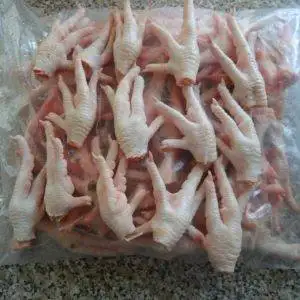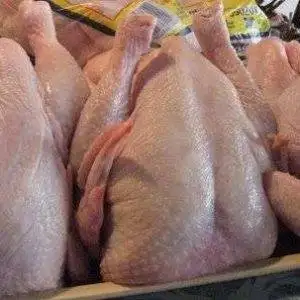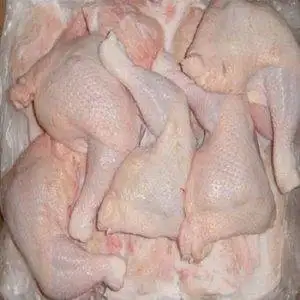Description
Halal Frozen Chicken Feet: Practical Tips & Best Practices
To get the best out of Halal Frozen Chicken Feet copacolc.com, consider:
-
Buying Tips
-
Look for reputable halal certification logos Halal Frozen Chicken Feet.
-
Check date of freezing, packaging integrity.
-
Buy from trusted suppliers who maintain cold chain.
-
Inspect for discoloration, freezer-burn; avoid if yellowish or smell off.
-
-
Thawing & Cleaning
-
Thaw in refrigerator rather than at room temperature to reduce bacterial risk.
-
Rinse well; you may blanch briefly to remove impurities or outer skin.
-
-
Cooking Suggestions
-
For broths: simmer long (several hours) to extract collagen and gelatin fully.
-
For crispiness or snacks: some chefs blanch then deep-fry; or grill/fry after seasoning.
-
Spices and aromatics: ginger, garlic, star anise, chili etc. work well.
-
-
Storage
-
Keep frozen until close to usage; once thawed, cook promptly.
-
If you have leftovers, store cooked portions in refrigerator and use within safe time (often a few days).
-
-
Ethical & Sustainability Considerations
-
Sourcing from farms with good welfare practices.
-
Ensuring minimal waste: freezing helps reduce spoilage.
-
Possibly using chicken feet for stocks reduces waste of parts otherwise discarded.
-
Challenges in Producing & Marketing Halal Frozen Chicken Feet
While promising, there are some challenges and limitations:
-
Perception / Demand Variation: In some markets, chicken feet are seen as low-status food, or are unappealing visually. Consumer education may be needed.
-
Supply Chain Integrity: Ensuring continuous halal compliance across all steps (slaughter, processing, freezing, packaging). Any breach may harm reputation.
-
Quality & Texture Issues: Improper freezing or thawing leads to freezer burn, tough texture, unpleasant smell.
-
Food Safety Risks: Pathogens if cleaning or handling is poor; risk of spoilage if cold chain breaks.
-
Regulatory Challenges: Multiple halal standards globally; exporting requires compliance with both origin and destination rules.
-
Cost Considerations: Freezing, packaging, certification all add costs; those can eat into margins especially for a product that is often priced lower than premium meat cuts.
Case Study Examples
-
Suppliers: Zeki Frucht GmbH offers frozen chicken feet with halal certification, emphasizing the product’s gelatinous texture and its use in broths, stews, etc. Zeki Frucht GmbH
-
Retail Product Listing: OnestopHalal lists “Halal Chicken Feet: 100% Zabiha Halal Certified … sourced from chickens that are hand-slaughtered … Nutrition & Info … Protein: 22g per 4 oz …” showing how a product is positioned and labelled. One Stop Halal
These demonstrate how businesses communicate value: halal assurance, nutritional content, culinary uses.
SEO Considerations: How to Market Halal Frozen Chicken Feet
If you are writing content, marketing or selling these products, consider the following to improve SEO and reach:
-
Keywords to target: “Halal chicken feet”, “frozen chicken feet”, “chicken feet halal certified”, “halal gelatin stock”, “halal broth ingredients”, “buy halal chicken parts”, etc.
-
Long-tail keywords: “how to cook halal frozen chicken feet”, “benefits of chicken feet for joints skin”, “halal chicken feet supplier [region]”, etc.
-
Content ideas: Recipes, nutritional benefits, buyer’s guide, halal certification explained, sustainable sourcing.
-
Meta description & titles: Should include main keywords (“Halal Frozen Chicken Feet”) and an incentive (“Health benefits”, “100% halal certified”, “Easy recipes”).
-
Images & Alt text: Show packaged product, cooked dish, step-by-step prep; alt texts like “Zabiha halal frozen chicken feet package”, “gelatinous chicken feet broth”.
-
Rich content: Videos (how to clean & cook), infographics (nutrition breakdown), FAQs (are chicken feet halal? yes if slaughtered properly; are there small bones? etc.).
-
Local SEO: If selling in a particular country, include “halal chicken feet in São Paulo”, “freezing halal chicken parts Brazil”, etc., to capture local demand.
Recipes & Serving Suggestions
Here are example recipe frameworks and serving ideas for using halal frozen chicken feet:
-
Gelatin-Rich Bone Broth
-
Ingredients: Halal chicken feet, water, onion, garlic, carrots, celery, salt, pepper, optional herbs (bay leaf, thyme).
-
Method: Thaw, clean (remove outer skin / nails), blanch briefly. Simmer on low for 4-6 hours or more. Skim foam. Strain. Use as base for soups or drink as is for collagen.
-
-
Spicy Braised Chicken Feet
-
Thawed and cleaned feet, marinated with soy sauce (or halal soy), garlic, ginger, chili paste.
-
Braise until tender, reduce sauce until thick and glossy. Serve over rice or with bread.
-
-
Deep-Fried Snack
-
After cleaning, blanch, then batter or coat with flour/spices, deep-fry until crispy. Could be served with dipping sauce.
-
-
Stew with Vegetables
-
Combine chicken feet with potatoes, carrots, onions, spices (e.g. turmeric, paprika), simmer until all ingredients tender; chicken feet help thicken naturally.
-
-
Dim Sum-Style Braised Feet
-
Typical Chinese style: deep-fried (or at least pre-cooked), then braised in a sweet-savory sauce with black bean, soy, sugar, chili, garlic, etc.
-
Global Insights & Regional Focus
-
In Asia (China, Philippines, Indonesia, Malaysia) chicken feet are staple items; halal variants are common in Muslim majority areas.
-
In Middle East and North Africa, chicken feet are less common as a main dish but used in soups or traditional stews.
-
In Western countries, halal chicken feet are finding niche markets: specialty halal butchers, ethnic grocery stores, online halal food retailers.
For Latin America / Brazil: the halal market is growing (Muslim communities, export potential). Frozen halal poultry products are increasingly exported. Incorporating halal frozen chicken feet into Brazilian markets could meet both domestic niche demand and export opportunities.
Environmental and Sustainability Aspects
-
Waste Reduction: Chicken feet are often considered by-products. Utilizing them reduces waste.
-
Energy Use: Freezing requires energy; sustainable cold chain practices help mitigate environmental impact.
-
Animal Welfare: Consumers of halal products often care about welfare standards. Ethical treatment, less stress before slaughter, proper housing helps.
Conclusion
Halal frozen chicken feet are a product that combines cultural culinary tradition, nutritional benefit, and modern supply chain convenience. When produced under strict halal conditions, frozen properly, and marketed with transparency, they offer value to cooks, consumers, and businesses alike. Challenges like quality control, consumer perception, and logistics exist, but opportunities—especially in growing halal markets around the world—are significant.






Reviews
There are no reviews yet.